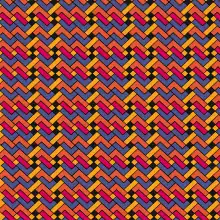Fibonacci quasicrystal
A Fibonacci crystal or quasicrystal is a model used to study systems with aperiodic structure. Both names are acceptable as a 'Fibonacci crystal' denotes a quasicrystal and a 'Fibonacci' quasicrystal is a specific type of quasicrystal. Fibonacci 'chains' or 'lattices' are closely related terms, depending on the dimension of the model.[1] While it is used mostly as a theoretical construct, physical models are implemented in order to verify the concept empirically. Most of its applications pertain to various areas of solid state physics.

The mathematical properties of the Fibonacci word and related topics are well researched and readily applied in such studies. The elements of a Fibonacci crystal structure are arranged in one or more spatial dimensions according to the sequence given by the Fibonacci word. The Fourier transform of such arrangements consists of discrete values, which is the defining property for crystals. In an algebraic form, the sequence is expressed via a matrix whose eigenvalues are Pisot-Vijayaraghavan numbers (PV numbers). This feature guarantees that its Fourier transform is discrete. Material waves with appropriate length interfere constructively when interacting with a Fibonacci-structured physical system. For instance, when submitted to X-rays, a Fibonacci quasicrystal produces Bragg peaks. Other features describing media behaviour such as damping, transmitivity, etc. can be evidenced on Fibonacci models.[2] Recently, Felix and Pereira investigated the thermal transport by phonons in periodic [3] and quasiperiodic [4] [5] superlattices of graphene-hBN according to the Fibonacci sequence. They reported that the contribution of coherent thermal transport (phonons like-wave) was suppressed as quasiperiodicity increased.
The Fibonacci-based constructions are an obvious example of quasicrystals which, in contrast to many well-known and typical examples of quasicrystals, do not possess a 'forbidden symmetry'. Their diffraction pattern is of a square type with the intensities arranged in a fractal pattern.[6]
References
- Searching database of physical papers reveals that 'Fibonacci chain' is the most frequently used; for instance more than 150 such items are found in arXiv and just a few dozen other appelations.
- Dharma-wardana, M. W. C.; MacDonald, A. H.; Lockwood, D. J.; Baribeau, J.-M.; Houghton, and D. C. (1987-04-27). "Raman scattering in Fibonacci superlattices". Physical Review Letters. 58 (17): 1761–1764. Bibcode:1987PhRvL..58.1761D. doi:10.1103/physrevlett.58.1761. ISSN 0031-9007. PMID 10034529.
- Felix, Isaac M.; Pereira, Luiz Felipe C. (9 February 2018). "Thermal Conductivity of Graphene-hBN Superlattice Ribbons". Scientific Reports. 8 (1): 2737. Bibcode:2018NatSR...8.2737F. doi:10.1038/s41598-018-20997-8. PMC 5807325. PMID 29426893.
- Felix, Isaac M.; Pereira, Luiz Felipe C. (30 April 2020). "Suppression of coherent thermal transport in quasiperiodic graphene-hBN superlattice ribbons". Carbon. 160: 335–341. arXiv:2001.03072. doi:10.1016/j.carbon.2019.12.090. S2CID 210116531.
- Félix, Isaac de Macêdo (4 August 2020). "Condução de calor em nanofitas quase-periódicas de grafeno-hBN" (in Portuguese).
- Lifshitz, Ron (2002). "The square Fibonacci tiling". Journal of Alloys and Compounds. 342 (1–2): 186–190. doi:10.1016/s0925-8388(02)00169-x. ISSN 0925-8388.